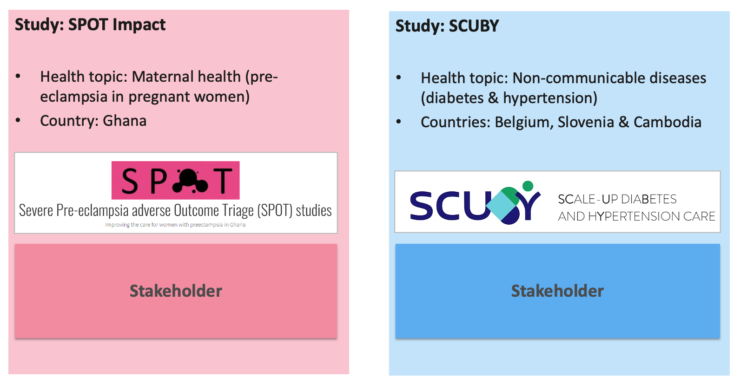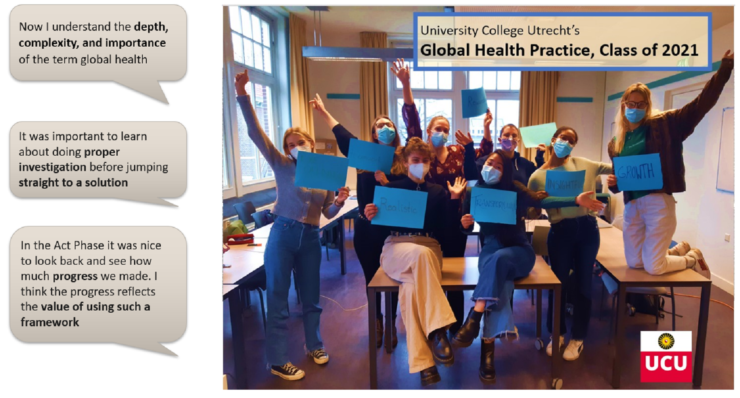Global Health Practice: Connecting students and ongoing real-world global health projects
In order to best prepare students for real-world challenges in the interdisciplinary work field of global health, we believe in the great potential of Community Engaged Learning (CEL) and engaging students in real-world projects to bridge the gap between theory and practice. We also value reciprocity in CEL, which is why we facilitate students’ learning from stakeholders as well as students’ contributions to these global health projects that we engage with in our course.
Background and Goals
The relatively new course ‘Global health Practice: Applying Research and Innovation’ (7,5 ECTS) was being developed for students at University College Utrecht*. The thought behind this course was to enable students to learn and experience what works and what does not work in real-world international global health projects, by linking them directly to experts involved in these projects. Students get introduced to and encouraged to explore the theoretical concepts, after which project experts of various projects are invited into our sessions to engage in conversations about how this applies to the real world. The project experts engage the students into the complexities of some of the dilemmas and challenges in these projects. That allows for the reciprocal character of Community Engaged Learning (CEL) for enabling the students to get involved, investigating the challenges further by making use of and further developing their own expertise and collaboration skills, and make recommendations for these projects.
The overarching course aim is to develop interdisciplinary solutions to global health challenges. The specific course objectives are as follows:
- Analyze a global health challenge and identify underlying causes
- Apply disciplinary knowledge to a global health challenge
- Apply an interdisciplinary approach to propose solutions to this challenge
- Apply an ‘equity lens’ on global health practice
- Critically assess proposed solutions to global health challenges
- Reflect on the contribution of their field of expertise to address these global health challenges, their own role in an interdisciplinary collaborative process, as well as the expertise and role of others in these processes.
*This advanced Bachelor-level course (UCINTGLO31) is part of the interdisciplinary courses offered at University College Utrecht. Students with a basic understanding of global health are eligible for this course, gained for instance after completion of the course Global Health (UCINTGLO21). It runs since 2020.
Project description
Educational design
Students are split into teams with 3-4 students per team. Each team is linked to a specific project for the entire duration of the course. Students work in their groups, and we also have plenary classroom conversations to enable identifying differences and similarities (and possible reasons behind it) between the different global health projects. We make use of the Challenge Based Learning framework to guide students through the three stages of learning about their global health topic: 1) Engage, 2) Investigate, and 3) Act. In each of these stages, students familiarise with the topic more.
Partner involvement
The global health projects that we invited into our course, and in which UMC Utrecht is an active partner in the international consortium, are:
Partners: Institute of Tropical Medicine Antwerp, Community Health Centre Ljubljana, National Institute of Public Health Cambodia, University of Antwerp, UMC Utrecht
Goal: Upscaling care for people with hypertension and diabetes type 2 in Belgium, Slovenia and Cambodia
Partners: University of Ghana, University of Amsterdam, University of Tennessee, Korle Bu Teaching Hospital, University of British Colombia and APEC Ghana
Goal: Improving maternal health (pre-eclampsia in pregnant women) in Ghana

Results
Our students learned to understand the complexities of a real-world global health challenge, and by doing that they further developed disciplinary and interdisciplinary skills. This was a valuable experience for them, but also for the teachers and partners, because of the energy that it created in the classroom and team sessions. In addition, the partners gained new perspectives on their project through the course set-up and student interaction, which the stakeholders brought forward in their international project teams. For one of the two projects, the SPOT Impact team, the students’ recommendations to engage Ghanaian religious leaders in raising awareness about pre-eclampsia as a prevention strategy was actually put into practice; a conference was organized to specifically start a dialogue with religious leaders of the Accra region. One of the students who was involved in the SPOT student team during the course, contributed to the realisation of this conference, as an intern in the project.

Reflection: lessons learned
The main challenge as a teacher was to sit comfortably in the role of the facilitator and encourage the students to be in the driver’s seat. To let the students take control over their learning process also means making room for students to make mistakes. It might feel scary at first, but it’s worth it!
Take home message
Partners
- Provide info and manage expectations
- Pre-arrange fixed dates and time slots
- Stay in contact throughout the course
Role of the teacher
- Teachers are facilitators. Embrace the uncertainty! But also: Stay connected to what is going on
- Leave the investigation up to the students, let them make ‘mistakes’. But also: Provide continuous feedback
